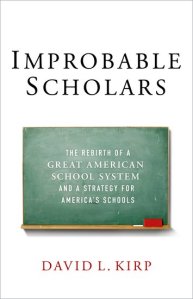InterACT: No Mystery Behind Improbable Scholars
If we could just fire the bad teachers…
If we had quality teacher evaluations…
If we had vouchers, charter schools, competition…
If we had common, world-class standards… a laptop or tablet for every student… smaller classes… a sharp reduction in poverty…
If you’ve been around education for a while, or if you follow education policy and education reform debates, you know plenty of these potential super-fixes, game changers, the “cage-busting” ideas that supposedly hold the key to transforming schools. Dig a little deeper, and I don’t think most serious thinkers would claim that there are any silver bullets, but still, the intensity around the debates show how firmly we believe in certain tenets of our educational philosophy.
 What if we could channel that intensity in a more productive direction, away from speaking and writing and blogging and tweeting, and into some productive work? What if the solutions to our problems are simpler than we think and we just need to roll up our sleeves to implement some basic, common sense reforms? David Kirp’s new book, Improbable Scholars, offers a compelling argument that building a strong school system doesn’t really hinge on adoption of any of the particular policy levers that comprise most of the public debate around education. It’s not that those policies don’t matter, but rather that the underlying levels of stability and trust really determine the success of those other policies. Kirp was kind enough to speak with me by phone last week, and in my next post, I’ll share some of that conversation. This post will focus on the book itself, which I heartily recommend to anyone involved in schools or interested in education reform.
What if we could channel that intensity in a more productive direction, away from speaking and writing and blogging and tweeting, and into some productive work? What if the solutions to our problems are simpler than we think and we just need to roll up our sleeves to implement some basic, common sense reforms? David Kirp’s new book, Improbable Scholars, offers a compelling argument that building a strong school system doesn’t really hinge on adoption of any of the particular policy levers that comprise most of the public debate around education. It’s not that those policies don’t matter, but rather that the underlying levels of stability and trust really determine the success of those other policies. Kirp was kind enough to speak with me by phone last week, and in my next post, I’ll share some of that conversation. This post will focus on the book itself, which I heartily recommend to anyone involved in schools or interested in education reform.
The core of the book details Kirp’s immersion in the school system and community of Union City, New Jersey. By spending days in elementary and secondary schools, talking with teachers, administrators, politicians, students and parents, Kirp gained insights regarding a district which has previously been recognized by many education observers. Pulling in a wide variety of statistics, studies, and other sources, Kirp supports his observations of Union City in ways that make the core argument widely applicable to American public schools.
While stability and trust are essential, it’s not as if the whole book comes down to attitudinal adjustments for struggling schools. Among the eight essential ingredients in Union City’s success, there is a continuum of what I’d call “policy heavy” and “policy light.” The former term applies to policies that require a dedicated budget, staffing, facilities, time, and administrative direction: e.g., full-day pre-school for all children starting at age three, and teacher support in the form of instructional coaches. The latter term describes organizational and community qualities that are entirely worthy of cultivation, and are even enhanced by smart policies, but ultimately come down to committed relationships; these essentials include school outreach efforts to engage parents and community, and maintaining a culture of caring in the school system. In between are the types of policies that can be formalized but still encounter varying interpretations, and depend on sustained effort by committed individuals and teams in order to have a meaningful impact. These are the more operational policies in schools and classrooms, goals relating to language development, cohesive curriculum, and data analysis.
In a struggling school or district, such policies can become like stop signs and posted speed limits: everyone knows what to do, but our actual fidelity to the rules varies widely, as do the consequences for inconsistency. A stressed or distrustful teaching staff can deflate such initiatives with half-hearted compliance, and an over-worked or tentative school leader can let such initiatives languish. Sometimes, the policy is tedious or counterproductive enough that it deserves this slow death-by-neglect, delivered by a staff that knows the eventual effect of its own sustained indifference.
That’s where trust and stability come into play. Kirp observes that if a school leader wants to make a significant change, it’s essential for everyone involved to trust the person leading the change, and trust that the change is designed and intended to benefit everyone involved. Stability is essential because sustained change takes time, and if turnover in leadership is frequent then it always seems to be imminent as well. Instability puts uncertainty into every interaction, and makes every mistake or flaw into a threat to be averted rather than a challenge to be solved. The way I’m presenting these ideas is somewhat reductive given the format, but Kirp is more careful that that, providing ample support and constantly citing studies to support his arguments. He doesn’t just quote a teacher saying that trust matters; the endnotes direct interested readers to research by Anthony Bryk and Barbara Schneider, and Karen Louis).
How did Union City do it? An important part of the answer is mayoral control. That’s an arrangement about which I’m quite skeptical in general. Kirp seems more neutral on the concept overall, citing failed examples while detailing the clear success of mayoral control in this particular case. Perhaps one key ingredient is that Union City is a small district, and the mayor can be personally connected to so many of the parents and school personnel. Kirp gives examples of the mayor and the superintendent getting involved in school operations details as fine-grained as the school bus pick-ups, not to mention their involvement in the minute details of people’s lives. The key is that the mayor and superintendent work well together, with both showing a sense of accountability to the other and to the people they serve. Each of them has worked hard on the right priorities and has been rewarded with a degree of job security that increases their ability to work hard on the right priorities. Nothing magical here, no edreform silver bullets – but how many urban districts, with familiar challenges like poverty and immigrant students learning English, can pull it off?
Kirp’s detailed recounting of time spent in pre-schools and elementary schools is especially helpful in understanding the significance of trust and stability when it comes to changing the ways teachers work and the ways school operate. Improvement is not left to chance, but rather results from an approach Kirp likens to “total quality management” as espoused by management guru W. Edwards Deming. At the pre-school level, the school district is ensuring that children receive quality early childhood education, not simply day care. The pre-school operators on the receiving end of mandates to improve need to trust that the people running the program know what they’re doing and that they will be around for the long-haul, providing the necessary support to build lasting change. In Union City, they’ve entrusted the early childhood education development to a skilled practitioner. They’ve also realized that their schools can improve the overall quality of teaching by leveraging the skills and expertise of their most effective teachers. Stability in the schools means that those effective teachers have been around long enough to build trusting relationships with their peers and administrators.
That trust pays off yet again when it comes to efforts to improve student performance. (Yes, that means test scores). Kirp is well aware of the problems with standardized testing as a blunt instrument in the assessment of students and schools. And the Union City teachers that he observed at length also recognize problems in the tests and in the amount of time focused on them. Kirp describes and seems to endorse a pragmatic approach to dealing with testing and data, recognizing that for all of their flaws, the test results are important to state-level policy makers: declining scores will endanger Union City’s autonomy and progress. With trust among the teachers and district leadership, it seems that Union City schools have become effective at collaboration and data analysis that meet the superficial needs of standardized testing while still supporting students’ deeper learning.
When readers see that one of the essentials Kirp highlights is a sense of caring, respect, and high expectations, it might be tempting to dismiss this as a non-actionable kind of idea. You can’t simply instruct a school board or a teaching faculty to have high expectations and act like they care. But those subjective qualities come through in some very concrete ways – in the Union City story, literally concrete. The city used to have two high schools, but in 2009, merged them into a brand new, state-of-the-art campus. A professional quality theater, science laboratories, dance studios, athletic facilities, television studio – this kind of investment in facilities reflects the high expectations of the community for their children to learn, and thrive, and move on from high school as skilled and motivated adults. (You can use these links to see dozens of photographs of the interior of the school and the exterior, including the rooftop athletic field).

Union City High School opened this student sanctuary in May 2013. Photo: Luigi Novi [CC-BY-3.0 (http://creativecommons.org/licenses/by/3.0), via Wikimedia Commons
The culture of caring is further evident in the brand new “student sanctuary” constructed outside the school and completed about six weeks ago. How many communities invest this much money and dedicate land so that student simply have a peaceful place to spend time? Union City is not a wealthy community, but the stability and trust that have built up over time have paid great dividends for the city’s schools and children.
I have to admit that much of the time I was reading Improbable Scholars, I was thinking, “Yes, but….” The essential elements Kirp describes are reasonably attainable, but there’s also a combination of personalities, legislation, and history in Union City that all had their part in shaping the schools’ success. What if we remove some of those key elements, like the charismatic mayor, the small size of the district, or the unique legal requirements around school funding in New Jersey? Kirp anticipates that line of questioning, and includes a final chapter with shorter descriptions of districts that have beaten the odds in Maryland, Texas, and California. He identifies key variables that are different, but finds that the essential elements of school success are still in place, along with the all-important stability and trust that make incremental sustained improvement possible.
Kirp has been quite busy promoting the book in various newspaper op-eds, in a CSPAN book discussion that took place in Union City, and he’ll be at the upcoming AFT TEACH (Together Educating America’s Children) conference in Washington, D.C. (The conference runs July 22-24, with Kirp participating on July 22). In my next post, I’ll share some of what Kirp told me by phone last week. Below, I’ve offered some quotations that I think capture important elements of the book, which I enthusiastically recommend.
“The research supplied me with the high-powered lenses I’ve used in making sense of what I saw, extracting the patterns from the particulars. Yet it can capture only a partial truth, for when it comes to education everything connects, from the crucible of the classroom to the interplay among teachers, from the principal’s skill as a leader to the superintendents’ success in creating an intermeshed system from a host of separate schools and the politicians’ role in setting the limits of a school district’s autonomy.” (11)
“We have heard a lot about inspirational teachers and superb schools. But excellent school systems are rarities. Many districts are run like a loose confederacy, with each principal calling the shots and each school free to go its own way. What sets Union City apart from the pack is that it has gone beyond this principal-as-savior approach and actually constructed an integrated school system. While there’s no romance in this enterprise, nothing to titillate the media, the superintendent and his top aides are performing an indispensable role. Behind the scenes, largely invisible to the students, they buttress each school while tying them all together, setting high expectations for the whole.” (74)
“[In] solid school systems, the hard work – the ‘plan, do, review’ process of continuous improvement – is neverending.” (200)
“Still, in every one of these successful districts [Union City, NJ; Aldine, TX; Montgomery County, MD; Sanger, CA], trust has been achieved even as teachers are both evaluated and supported far more intensively than in a typical school system. It isn’t the union that makes or breaks a district’s efforts to change outcomes for poor and minority students – it’s the district’s commitment to turning the personnel they have into the professionals they need.” (207)
“These districts didn’t change by behaving like magpies, taking shiny bits and pieces [of education policy or best practices] and gluing them together. Instead, each of them strove to develop a coherent system reaching from preschool to high school, based on evidence of what works in their own district, and they have kept tinkering with it, learning as they go.” (208, emphasis added)
This blog post has been shared by permission from the author.
Readers wishing to comment on the content are encouraged to do so via the link to the original post.
Find the original post here:
The views expressed by the blogger are not necessarily those of NEPC.


